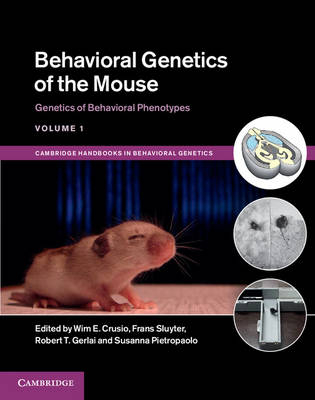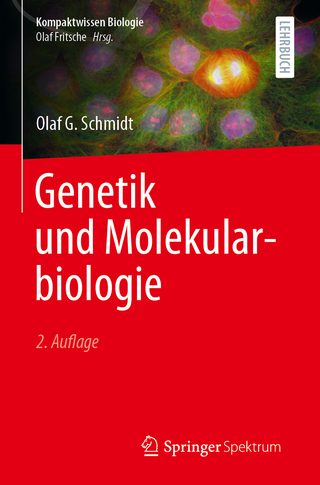
Behavioral Genetics of the Mouse: Volume 1, Genetics of Behavioral Phenotypes
Cambridge University Press (Verlag)
978-1-107-03481-5 (ISBN)
- Titel erscheint in neuer Auflage
- Artikel merken
The first volume in the new Cambridge Handbooks in Behavioral Genetics series, Behavioral Genetics of the Mouse provides baseline information on normal behaviors, essential in both the design of experiments using genetically modified or pharmacologically treated animals and in the interpretation and analyses of the results obtained. The book offers a comprehensive overview of the genetics of naturally occurring variation in mouse behavior, from perception and spontaneous behaviors such as exploration, aggression, social interactions and motor behaviors, to reinforced behaviors such as the different types of learning. Also included are numerous examples of potential experimental problems, which will aid and guide researchers trying to troubleshoot their own studies. A lasting reference, the thorough and comprehensive reviews offer an easy entrance into the extensive literature in this field, and will prove invaluable to students and specialists alike.
Wim E. Crusio is a Research Director at the French National Research Council (CNRS). With over 35 years experience in mouse behavioral neurogenetics and the phenotyping of mouse behavior, his recent interests cover mouse models of depression, autism and Fragile X Syndrome. Frans Sluyter is an expert in (wild) house mouse behavior and neurogenetics. His interests range from aggression, addiction, depression and (stress) coping strategies to gene expression profiles and consciousness. Robert Gerlai has held numerous positions in academia, biotechnology and the pharmaceutical research industry and is currently a professor in the Department of Psychology at the University of Toronto. He studies biological and genetic mechanisms of behavior using reverse and forward genetic and psychopharmacological methods in mice and zebrafish. Susanna Pietropaolo is currently a researcher at the French National Research Council (CNRS). She is an expert in the behavioral analysis of the laboratory mouse, with a special interest in inter-specific social behaviors. Her recent research focuses on mouse models of social dysfunction, including autism and Fragile X Syndrome.
Contributor list; Part I. General: 1. Current status of the field W. E. Crusio and R. T. Gerlai; 2. Natural neurobiology and behavior of the mouse: relevance for behavioral studies in the laboratory H. P. Lipp and D. P. Wolfer; 3. Ethogram R. T. Gerlai and W. E. Crusio; 4. Replicability and reliability of behavioral tests D. Wahlsten and J. C. Crabbe; Part II. Perception: 5. Audition J. F. Willott; 6. Behavioral measurement of mouse visual function G. T. Prusky and N. M. Alam; 7. Tactile system and nociception S. B. Smith and J. S. Mogil; 8. Olfactory acuity in Mus musculus H. Schellinck and B. Slotnick; 9. Taste genetics J. Boughter; Part III. Autonomous and Motor Behaviors: 10. Motor coordination in inbred mouse strains and the crucial role of the cerebellum R. Lalonde and C. Strazielle; 11. Reflex development F. Cirulli and E. Alleva; 12. Feeding and drinking R. J. Bodnar, S. R. Lewis and B. Kest; 13. Lateralization F. G. Biddle and B. A. Eales; 14. Rhythms and sleep: circadian and seasonal activity patterns B. Possidente; 15. Exploratory behavior W. E. Crusio; 16. Strains, SNPs and selected lines: genetic factors influencing variation in murine anxiety-like behavior A. Holmes; 17. Genetic influences on infant mouse ultrasonic vocalizations R. Benno and M. E. Hahn; 18. Startle behavior and prepulse inhibition C. F. Plappert and P. K. D. Pilz; 19. Mouse models of stress-induced depression-like behavior: stress vulnerability and antidepressant response as traits H. Gershenfeld; 20. Behavioral phenotyping of mouse grooming and barbering P. R. Canavello, J. M. Cachat, P. C. Hart, D. L. Murphy and A. V. Kalueff; Part IV. Social Behavior: 21. Social interaction C. Blanchard, J. Crawley, H. Arakawa and R. Blanchard; 22. Mouse sex: sexual differentiation and sexual behavior in Mus musculus L. Niel and D. A. Monks; 23. Nest-building behavior and the genetic correlation structure of adaptive phenotypes in house mice Abel Bult-Ito; 24. Aggression F. Sluyter, S. de Boer and S. C. Maxson; Part V. Learning and Memory: 25. Latent inhibition T. J. Gould and S. F. Logue; 26. Executive function: response inhibition, attention, and cognitive flexibility S. F. Logue and T. J. Gould; 27. Water navigation tasks D. P. Wolfer, G. Colacicco and H. Welzl; 28. Active and passive avoidance I. Branchi and L. Ricceri; 29. Radial maze W. E. Crusio and Herbert Schwegler; 30. Other mazes T. P. O'Leary and R. E. Brown; 31. Cued and contextual fear conditioning R. M. Gerlai; 32. Taste and odor H. Welzl and D. P. Wolfer; 33. Object recognition in the mouse E. Dere, A. Zlomuzica, M. A. De Souza Silva and J. P. Huston; Index.
| Erscheint lt. Verlag | 25.4.2013 |
|---|---|
| Reihe/Serie | Cambridge Handbooks in Behavioral Genetics |
| Zusatzinfo | 23 Halftones, unspecified; 62 Line drawings, unspecified |
| Verlagsort | Cambridge |
| Sprache | englisch |
| Maße | 222 x 280 mm |
| Gewicht | 1310 g |
| Themenwelt | Geisteswissenschaften ► Psychologie ► Test in der Psychologie |
| Medizin / Pharmazie ► Medizinische Fachgebiete ► Laboratoriumsmedizin | |
| Medizin / Pharmazie ► Medizinische Fachgebiete ► Psychiatrie / Psychotherapie | |
| Studium ► 2. Studienabschnitt (Klinik) ► Humangenetik | |
| Naturwissenschaften ► Biologie ► Genetik / Molekularbiologie | |
| Naturwissenschaften ► Biologie ► Zoologie | |
| ISBN-10 | 1-107-03481-7 / 1107034817 |
| ISBN-13 | 978-1-107-03481-5 / 9781107034815 |
| Zustand | Neuware |
| Haben Sie eine Frage zum Produkt? |
aus dem Bereich



